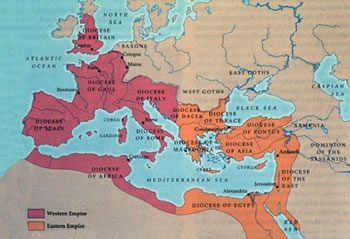A School for Prayer (20)
Mind-in-the-heart Prayer
By Fr Craig Larkin SM, 1943 - 2015
Hesychastic Prayer in the Eastern Church (1)
The Church of the East
The Church of the East is the part of the Christian Church which developed in the eastern side of the Roman Empire from the 4th century onwards.
Both the Church of the East and the Church of the West have their roots in the earliest Christian experience. Both are rooted in the Faith as outlined in the first Seven Councils of the Church.
The difference between the Church of the East and that of the West is seen clearly in its music, its liturgy, its style of worship, its dress, its spirituality, and in some aspects of its profession of faith.
Over centuries, language, culture, misunderstandings, national and cultural conflicts have deepened the gap between the two parts of the Church, and they have become separated, alien to each other, even hostile. We are like family members who resemble each other but who don’t talk with each other.
 The Roman Empire divides
The Roman Empire divides
After Constantine had become Emperor in 312, he transferred the capital of the Roman Empire from Rome to Byzantium, re-naming it Constantinople in 330. He placed the two “sides” of the Roman Empire under the governance of two Emperors.
The Empire was always regarded as one, but with two parts – the West and the East.
Gradually, however, the two parts drew apart, separated by language (Latin in the West, Greek in the East), cultures, nationalism, and the misunderstandings and intolerances that go with all of that.
While the Western Roman Empire was threatened and weakened by the invasions from the tribes of northern Europe, the Eastern Roman Empire, centred in Constantinople, grew stronger. The Byzantine Empire expanded westwards. Meanwhile, each side developed its own political ambitions and its own experience of theology. The cleavage between the two sides widened.
Two decisive moments in this history of separation were in 1054 when religious leaders of East and West mutually excommunicated each other from the ‘one Church’; and in 1204, when the Crusaders of the 4th Crusade sacked Constantinople. The Church of the East has never forgotten this moment.
But given that the Church of the East and of the West are parts of the one Body of Christ, the plea of Pope John Paul II to all Christians is urgent: “The Church must learn to breathe with both its lungs”.
A particular tradition in the Eastern Church is the ‘prayer of the heart’, or more accurately the ‘prayer of the mind-in-the-heart’. The ‘heart’ has a major importance in Scripture.
The ‘heart’ in Scripture
A careful reading of Scripture, especially of the Psalms, shows how deep and varied the word ‘heart’ is.
The word is found 835 times in the Scriptures. Its meaning is much richer than our restricted understanding of the heart as simply a bodily organ, or the ‘place’ where we have feelings and emotions.
a) The ‘heart’ is where a person thinks and decides
In the heart a person thinks, knows, sees, understands, meditates, ponders, believes, doubts, counsels, considers, is illumined, becomes wise.
“May the thoughts of my heart be pleasing to you, O Lord” (Psalm 19:14).
b) The ‘heart’ is where a person desires and loves
The heart desires, wishes for, lusts, envies, covets, is enticed, turns away from or towards God. The heart directs actions.
“They are happy, whose strength is in you, in whose hearts are the roads to Sion” (Ps 83:5).
c) The ‘heart’ is where a person wills
The heart intends, is set on things, is ‘with’ another. In the heart one decides and keeps a direct path.
d) The ‘heart’ is the source of emotions
In the heart a person loves, cares, feels compassion, forgives, is joined in love with another. In the heart a person is glad, is merry, trusts, has courage, is encouraged, is gentle, humble, filled with joy, delights, sings and makes music.
In the heart, too, one hates, despises, makes wicked plans against another, is vengeful, feels sorrow, despair, anguish, is grief-stricken and wounded. The heart melts like wax with fear. The heart may be stubborn, stony, hard, unrepentant, slow, obstinate, divided, full of deceit, heavy; or it may be a ‘heart of flesh’.
The heart is where prayer takes place: “I remembered the years long past. At night I mused within my heart, I pondered and my spirit questioned” (Psalm 76:7).

 Entries(RSS)
Entries(RSS)